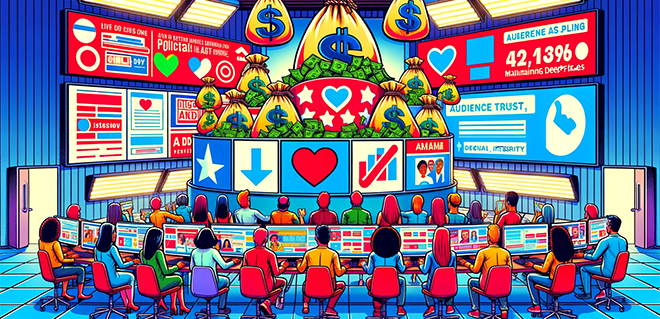 |
||||||||||
|
||||||||||
| AdImpact Projects Political Ad Spend to Reach $10.7 Billion |
 |
It's no surprise that political ad spend is booming this year, especially with a pivotal presidential election approaching, but the spend is higher than analysts initially expected. AdImpact originally forecasted political ad spending at $10.2 billion, but it has shot up to $10.7 billion. They expect broadcast ad spend to reach $5.4 billion, up from $5.1 billion, while they project cable spend to hit $1.93 billion, up from $1.9 billion. Connected TV spend is forecasted to rise to $1.51 billion from $1.35 billion. It should be no surprise to our audience how much ad spend goes into CTV. Jeremy Haft predicted that CTV would decide who would win the White House. While Haft agrees that CTV still has some leg work to prove it can influence voter behavior, it has its benefits. He writes that CTV "is uniquely equipped to drive tangible outcomes that candidates care about (besides votes on election day), such as site visits, sign-ups, and donations." As of June 27, 2024, political ad spend is $3.05 billion, surpassing the $2.54 billion spent by this time in the 2020 cycle. AdImpact projects this election cycle to be the most expensive on record, with a 19% growth over the 2019-20 cycle. Politicians, consumers, advertisers, and publishers will pay close attention to CTV this political season, and we will tackle this at our upcoming PubForum Boston conference on August 4-6. In a session titled "Navigating the 2024 Political Ad Surge: Opportunities and Risks," we will discuss the do's and don'ts of CTV political advertising. While the benefits are immense, streaming platforms and advertisers must still consider inventory scarcity, higher ad prices, and brand safety concerns amidst AI-generated misinformation. – AB |
|
| Cookie Cravings: Industries Still Nibbling on Third-Party Data As Privacy Sandbox Looms |
| Well, folks, it looks like some industries are still savoring the sweet taste of third-party cookies, even as the privacy-first buffet is being laid out before them. According to fresh Q1 2024 data from 33Across, reported by EMARKETER, the food and drink and travel sectors are the cookie monsters of the ad world, with a whopping 86% of their programmatic ad buys still munching on soon-to-be stale identifiers. Talk about having your cookie and eating it too. But before we judge these digital gourmands too harshly, let's dish out some context. The shift towards cookieless alternatives is moving slower than molasses across the board. Since Q3 2023, the share of US cookie-alternative programmatic ad buys in these same industries has barely budged – we're talking a single, lonely percentage point. It's as if the entire ad tech industry is stuck in a game of "Cookie, Cookie, Who's Got the Cookie?" In the land of Privacy Sandbox, some DSPs are playing 4D chess while others are still setting up the board. Our pal, Paul Bannister, Chief Strategy Officer, Raptive, recently shared insights about DSP spending with Google's Protected Audience API (PAAPI), showing most players dipping their toes in with about 1% of ad spend. But let's not forget the elephant (or should we say, the cookie jar) in the room: getting big advertisers on board this privacy train is like herding cats... if the cats were multimillion-dollar corporations. Google's own DV360 is lagging behind AdWords in PAAPI spend, proving that even the cookie-cutters themselves are finding it tricky to switch recipes. For publishers, here's where things get spicy: If third-party cookies vanished today, publishers could lose up to 60% of their ad revenue, according to Criteo’s recent data. Yikes! This news puts the slow adoption of cookieless alternatives in a whole new light. So, what's a publisher to do in this half-baked situation? Keep your Prebid.js fresh, brace for bumpy revenue reporting in GAM, and maybe start looking into attention metrics as a new way to prove your worth. After all, in a world without cookies, capturing eyeballs might just be the next best thing to tracking them. As we watch this slow-motion cookie crumble, one thing's for sure: publishers need to start cooking up new strategies, and fast. Whether you're a cookie connoisseur or a privacy pioneer, the next few quarters are going to be one wild ride. Buckle up, buttercup – and maybe pack some milk for all those leftover cookies. - LdJ |
| Retailers Team up With Meta and Google to Access Amazon’s Ad Dollars |
| The fight for ad dollars is heating up, especially in an increasingly oversaturated market. And if one thing is true for retail media, everyone is dipping their hand into the shopper data pie because it's a vast treasure of first-party data. Consequently, this means that the little people need help from those up top, and who else should we ask other than two of the most influential members of the Duopoly? Retailers have found new allies in Meta and Google to compete with Amazon for ad dollars. Several recent partnerships have emerged: 1. Instacart is making YouTube ads shoppable. 2. Shopify is launching a program in Canada to buy Meta and Google ads for merchants. 3. Kroger has agreed to sell targeted Meta ads for grocery brands. Retailers are extending their ad businesses beyond their e-commerce sites to attract larger ad budgets. As more retailers develop advertising capabilities, advertisers seek access to broader audiences on major platforms. Retailers leverage their shopper data to precisely target ads and track their effectiveness beyond their websites. For instance, 35% of Target's ad revenue comes from non-owned sites. The objective is to rival Amazon's $46 billion ad business, which relies heavily on its technology and personnel. – AB |
 |
|||||||
|
|||||||
 |
|||||||
 |
|||||||
|
| @{optoutfooterhtml}@ |








